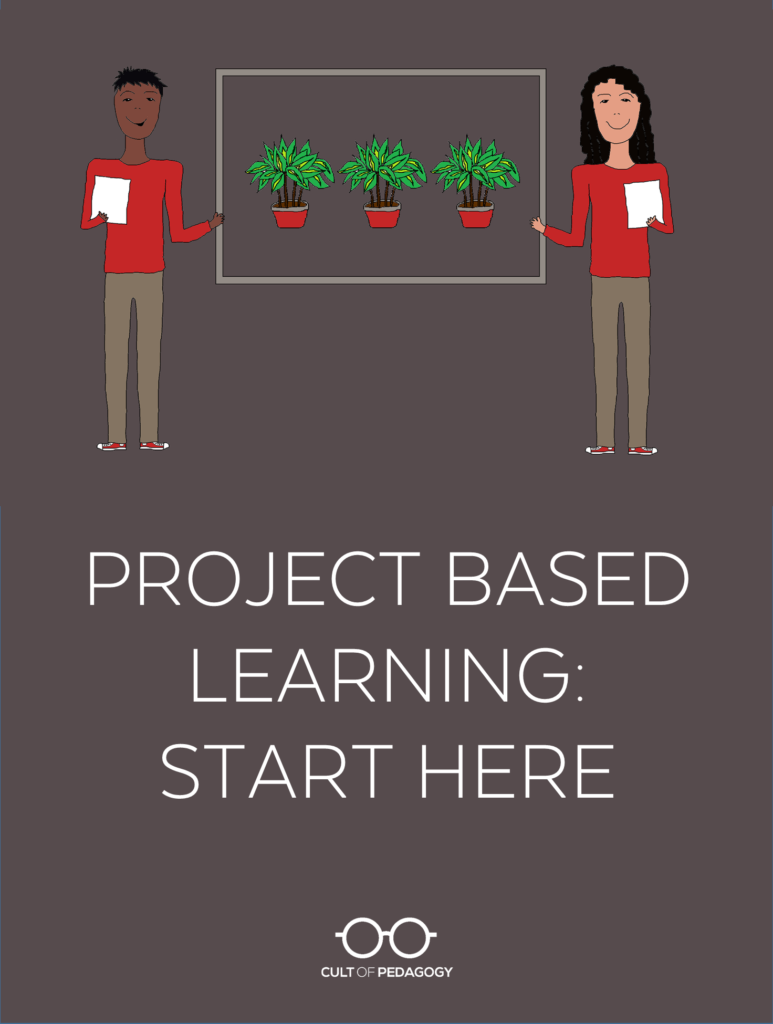
Despite the popularity of project based learning, a lot of teachers haven’t gotten around to trying it yet. You’ve been meaning to; you just haven’t had time to learn how. Or maybe you’re doing something you call project based learning, but you have a nagging feeling that you might not be doing it quite right.
If any of this sounds familiar, then this will help. One reason PBL might be hard for some teachers to start is that there’s just so much stuff out there about it. Who has time to wade through it all? To solve this problem, I went out in search of the clearest, most authoritative information on PBL and put together a collection of materials that will help you get your feet wet, plus links to more resources for when you’re ready to dig deeper.
What exactly IS project based learning?
The easiest way to explain PBL is to compare it to what we think of as “traditional” instruction: In a traditional classroom, we deliver content to students, give them opportunities to practice or apply what they learned, and eventually conduct a summative assessment—this could take the form of a test or it could be more of a performance assessment, like an essay, a speech, or a project of some kind. Careful, though: The “project” in many cases is often something like a poster that merely regurgitates the facts students were taught in the unit.
With project based learning, the content is baked inside of a long-term project, a real-world problem students need to solve in a creative and authentic way. In the process of solving the problem, students also meet required standards, but this work is integrated into the project, not separate from it.
Take the study of viruses, for example. A PBL project might ask students to educate their peers on the best ways to prevent the spread of viruses in school. To do this, they would need to study microbiology to understand how viruses work, research prevention tools, then use their writing and speaking skills to determine the most effective means to convince their peers to change their habits; this may come in the form of a video or poster series.
In this Edutopia video, we get a good overview of how PBL is different from the kind of instruction most of us are used to.
This video is part of a series called “5 Keys to Rigorous Project-Based Learning.” To watch the whole 5-part series, click here.
Why is everyone going crazy for PBL?
Student Engagement
For as long as school has been around, students have asked, “When am I ever going to use this stuff in real life?” And they have a point: Because our default setting is to teach our material out of context, students rarely see its relevance. Even if we are able to design a project that has them apply their knowledge in real-world ways, the project is often hypothetical—students know it’s still a school assignment, so they aren’t as engaged as they would be if it were real. Project based learning doesn’t just add a dose of relevance to the standard model; it builds the learning within a relevant context from the very start, so students are naturally more engaged.
21st Century Skills
Now that technology has made it easy to find any fact in a matter of seconds, the ability to regurgitate information is no longer valued the way it once was. It is becoming abundantly clear to educators and employers that students need to be able to do more than spit out facts. In a 2015 survey conducted by the National Association of Colleges and Employers, employers listed the skills they valued the most in new hires. In the top 10 were qualities like the ability to work on a team, problem-solving skills, written and verbal communication skills, and initiative. All of these are developed beautifully in project based learning.
Improved Academic Performance
The research on project based learning tells us that it closes the achievement gap for underserved populations, improves understanding and retention of content, and increases motivation for all students. For more information on these studies, see the Buck Institute’s Research Summary on the Benefits of PBL.
Okay, but what does it really look like in real life?
To really understand project based learning, you need to see it in action. Here are three examples.
Media Saves the Beach
When California cut its budget for water quality testing, these San Diego high school students were charged with figuring out how to test the water quality on their own, then educate the public about ways they could protect and improve water quality in their daily lives. This project engaged student learning in two content areas: science knowledge was required to study the problem and develop solutions, and English language arts skills were needed to effectively communicate their ideas to the public.
Schenk Courtyard Project
Students at Schenk Elementary School were asked to redesign an underutilized courtyard space on the school campus. They drafted, revised, and presented their ideas in formal presentations to their classmates. They then met with architects, who shared their own plans and took student suggestions. I thought the project could be made more rigorous with the addition of budgeting, having students research the material and labor costs for their ideas and determine what would fit within the school’s budget, but even without that, the level of student engagement is pretty fantastic.
Hydroponics and World Hunger
In this TeachThought podcast, 4th grade teacher Nan Arant describes how her students worked to develop a solution to world hunger by studying alternative ways to grow plants; specifically, hydroponics and aquaponics. She also talks about how discovering PBL has changed the way she feels about teaching.
More Examples
To see other project based units, take a look at these resources:
- The Buck Institute’s Project Search page allows you to browse hundreds of projects, and you can narrow your search by content area and grade level.
- The projects page of High Tech High is a collection of student-completed projects. These also include written reflections from the teachers who taught the units.
- TeachThought keeps a long list of ideas for project based learning you can explore for inspiration.
How do I plan a project based unit?
Although a single, authoritative set of step-by-step instructions isn’t easy to find, these two articles describe processes that can help a beginner get started. They have some differences, so I would advise you to read through both and decide which one sounds right for you:
Problem-Based Learning: Six Steps to Design, Implement, and Assess, Vincent R. Genareo PhD and Renee Lyons, Faculty Focus
Practical PBL Series: Design an Instructional Unit in Seven Phases, Amber Graeber, Edutopia
What’s the difference between project-based learning and problem-based learning?
The short answer is that they are more or less the same, although it could be argued that there are fine points that make them different. In this 2015 Edutopia post, Buck Institute editor-in-chief John Larmer lists a number of terms that are often used interchangeably with project based learning, including inquiry-based learning, design-based learning, and case-based learning, and he explains the difference.
How do I handle grading with PBL?
Take a look at Edutopia’s collection of resources on assessment in project based learning.
Where can I go to keep learning?
Once you’re ready to really dig into the finer points of PBL, head to one of these sites. Each has a solid collection of well-researched resources that can teach you how to implement PBL and inspire you to make it happen in your classroom.
Webinar: Getting Started with Project-Based Learning
This free 30-minute, on-demand webinar tackles the seven most common PBL questions and includes a PBL toolbox of resources and six sample units. Learn more here.
The Buck Institute for Education (BIE)
It seems that every PBL trail eventually ends at BIE, an organization that has led the charge toward project based learning for 25 years. Here’s how they describe their mission: “Our highest priority is to help teachers prepare students for successful lives. We do this by showing teachers how to use Project Based Learning in all grade levels and subject areas. As a mission-driven nonprofit organization, BIE creates, gathers, and shares high-quality PBL instructional practices and products and provides highly effective services to teachers, schools, and districts.” The site includes videos, planning forms, and recorded webinars that teach the finer points of PBL. It’s also worth your time to study their Gold Standard PBL model, which outlines the criteria for the most rigorous and effective project based learning, and to look at their wide range of professional development opportunities. Visit BIE here.
Edutopia
Although Edutopia doesn’t focus exclusively on PBL, they have built an extensive library of articles and videos on the topic. In fact, project based learning is one of Edutopia’s six core strategies, so they spend lots of time looking at it from different angles, providing tools to do it well, and profiling schools that are implementing it in exemplary ways. Start exploring Edutopia’s PBL collection now.
New Tech Network
New Tech is a network of around 175 U.S. and Australian schools whose curriculum is built primarily on project based learning. Nearly every video I’ve seen of PBL in action happens to be filmed at a New Tech school, and they’re all impressive. Visiting their site will give a PBL newbie lots of opportunities to see this practice in action. To learn more, visit their website, or watch a few videos showcasing the best projects New Tech students have done.
What if I want even more?
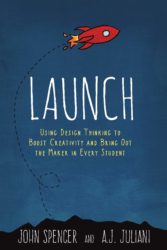 If you’re on a roll, you might also want to check out A.J. Juliani and John Spencer’s new book, Launch: Using Design Thinking to Boost Creativity and Bring Out the Maker in Every Student. Although the book is not strictly about project based learning, it offers a flexible framework for learning experiences that PBL fits right into, and it will really get you excited about tapping into student creativity in your classroom.
If you’re on a roll, you might also want to check out A.J. Juliani and John Spencer’s new book, Launch: Using Design Thinking to Boost Creativity and Bring Out the Maker in Every Student. Although the book is not strictly about project based learning, it offers a flexible framework for learning experiences that PBL fits right into, and it will really get you excited about tapping into student creativity in your classroom.
So where will you start?
If this has inspired you to get started with project based learning, share your plans with us! In the comments below, talk about the project you’re hoping to start with. If you have questions, this is the place to ask them. The most important thing to do is just start—it absolutely WILL NOT be perfect the first time around, so get the first one going and learn from it. Then, instead of saying you still haven’t gotten around to trying PBL, you can officially call yourself an experienced PBL teacher. ♦
Join the Cult of Pedagogy mailing list and get weekly tips, tools, and inspiration—in quick, bite-sized packages—all geared toward making your teaching more effective and fun. You’ll get access to my members-only library of free downloadable resources, including my e-booklet, 20 Ways to Cut Your Grading Time in Half, which has helped thousands of teachers spend less time grading!

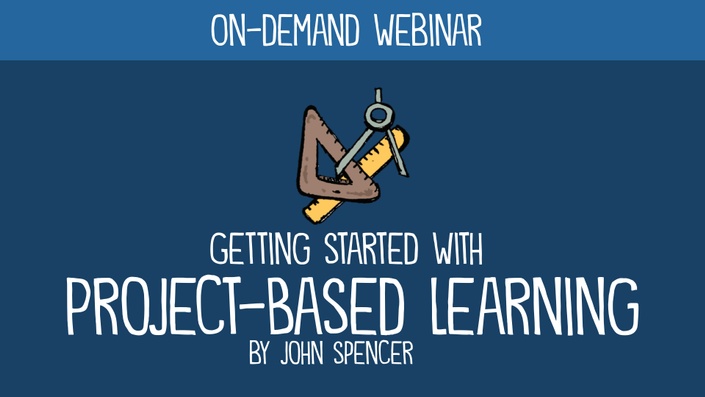

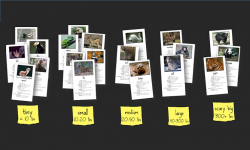

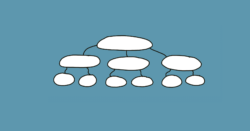
I love this article! I am joining a team of middle school teachers and we are implementing PBL in a Montessori classroom. I think this information will help us as well as the parents of our students as we return to school and begin this program. Thanks!
Thanks Jennifer….so good to see this post on P.B.L and all of the insightful materials to use. Over here in New Zealand we are moving towards modern learning environments and I wondered what you know in regards to the best ways of planning for and organising K 2-4 children. It seems to have been successful in K – K2 with play-based learning; and further up the school with differentiated learning/PBL/flipped classrooms, but I need advice for those middle children. Any thoughts?
Thanks for this helpful guide, Jennifer. The most inspiring example of PBL I’ve seen is from a college friend named Matt, also teaching here in New Jersey. He’s had his English classes identify issues, then create non-profit organizations to help serve the people suffering with those issues. Peruse his twitter for some awesome examples:
https://twitter.com/MrMorone
Thanks again!
Thanks for offering these resources. Lots to explore here! I’ve already gone to a few of the sources you’ve suggested. Although I’m familiar with some of them, there are new ones to explore!
Enjoyed the summary. Required to complete a PBL activity with my Level 1 English Language Learners (newcomers). What would this look like? Any suggestions/resources you can offer?
Hey Nicole!
This is Debbie, a Customer Experience Manager with Cult of Pedagogy. You may want to check out the site’s PBL board and ELL board on Pinterest to get some ideas. You may also want to check out the following site from Scholastic: Project Based Learning: A Tool for Engaging ELLs. Hope this helps — have fun!
Hello Jennifer! Great article, lots of good insights and links about PBL I will be checking. I am part of the team of RoadAmico, The Walking Classroom, a platform that allows educators to develop innovative field-based lessons and exclusive place-based activities so that students can step out of the classroom and enjoy unique experiences off campus, develop and complete assignments related to particular places, and belong with their environment everywhere in the world.
To understand how it works you can have a look to this video: https://www.youtube.com/watch?v=rEsof15xOyI
Or check our platform: https://www.youtube.com/watch?v=rEsof15xOyI
I’m in my third year teaching with the Learner Active Technology Infused Classroom (LATIC) model. It is very heavily PBL based and especially helpful helpful in the unit planning phase. I find my students do well with authentic tasks paired with unit rubrics that help them self-assess their growth and progress. They schedule their time and make choices from differentiated activity lists to work towards real-world solutions to real-world problems. I’m hoping to carry some of the successful practices into the summer with some tutoring students as a way to help stimulate engagement in the face of all those other alluring summer vacation alternatives!
This includes great background information for those who need it! Then it has some fantastic examples that can be tweaked for different purposes. Lastly, I loved that it also has the resources at the end for someone who wants to learn more. I am sharing this with my staff!!!
This article was very inspiring! I am trying to create a unit using a project on the War on Terror for my seniors. Would love to hear some ideas on how to go about it.
Hi Libby! I work for Cult of Pedagogy, and while I don’t have any specific War on Terror PBL ideas, I would check out our Pinterest board on Project-Based Learning.
As a side note, do you know about NewseumED? It’s kind of really awesome. I did a quick search on War of Terror and found a few things you may find useful.
Hope this helps!
Project based learning doesn’t just add a dose of relevance to the standard model; it builds the learning within a relevant context from the very start, so students are naturally more engaged.
I’ve worked on PBL with over 6000 teachers and close to 400 schools. Wrote the BIE Handbook. My advice? Go online! INTRO to PBL and Build Your Inquiry Based Skillset. pblglobal.com/mobile-learning.
I’m a teacher-Librarian, about to embark on PBL. Our school is situated in a warm land of agriculture and I’m wanting students to study the affect of pollution and loss of habitat on our agricultural lense, specifically through the lens of the honey bee. The unit is for grade 6/7s and I was hoping for some guidance in narrowing down the overarching Question. Many thanks. Excellent article, btw!
Hi Darcie! I bet I can find help for you on Twitter. Maybe you can tell me what some of your ideas have been for that question?
The Schenk courtyard project you mention is a great example of how teachers forget to give instruction about a critical element of PBL: presenting. I wrote about that here: https://goo.gl/AatgBD
Every one of those students is capable of much better speaking and presenting. Simple little lessons about verbal viruses (“There will be like cement for like water so like ducks can…”), eye contact (point, and then look at the audience/camera), life (“and a Kentucky Fried Chicken…” Wait a second! That’s a great line. Sell it! Add some life!! “and a…KENTUCKY…FRIED…CHICKEN!” Don’t do all the good work without giving students the ability to speak well. Don’t sell them short.
Thank you for this article! I finally have 4 of 8 units PROJECT-BASED! The students are totally engaged, I only direct instruct grammar they can use for their presentations, etc. One tip I have is to use the same rubric for each project, all year! Also, an example of a project that goes over extremely well is design-a-field-trip. Students vote on all the presentations! This year we learned about the guacho way of life in South America and ate at FOGO DE CHAO! Students loved it and it was all their design. Thank you for bringing learning to life! -Nicole
Hi Nicole,
Do you teach high school language class? My classes meet three times a week for 80, 60 & 60 minute sessions. Do you think that PBL would work well under these circumstances? Especially when they have a myriad of commitments to sports, retreats and clubs?
Thanks,
Pedro
I am surprised, that nobody even tried to mention Warka Water, so that under advantaged communities might be able to gain a boost by generating free water. This may also mean that there is a platform by which to allow tribes nationally to gain yet another way by which to generate income both inside and outside of the tribe.
Thank you for the excellent detail Jennifer,
Relatedly Hattie downgrades inquiry and problem based learning with his rankings. But a number of academics have pulled his interpretation of the research apart. see here – https://visablelearning.blogspot.com.au/p/problem-based-learning.html
and here –
https://visablelearning.blogspot.com.au/p/inquiry-based-teaching.html
Thank you so much for this wonderful article and the resources you provide. I am currently leaving one school that is in transition to IB MYP where these resources will be useful, and I am moving to be the MYP
Coordinator at a different school, so I can share these resources with teachers that are new or beginners with PBL.
I have been using PBL for many years now, and while I have resources I have found useful to me in my quest to understand more, your succinct summary is perfect for teachers who are a bit more hesitant to dip their toes into this pool.
Once again, thanks so much for your wonderful blogs and resources you share!
I have a problem with some of the PBLs I observed, in that I’m not sure how they would address the standards I have to teach. I don’t have time to both teach the standards (6th grade Comprehensive Science) and also do a PBL. Is there an example of one that incorporates the exact standards they have to address, rather than picking out a PBL and Then seeing what standards they can pull out of it? I can’t do Nature of Science all year, lol.
You might want to check out Jenn’s Project Based Learning board on Pinterest and Buck Institute for Learning.
Hi Shelley,
I struggle with this as well. I feel that we barely have enough time as it is to teach what standards are required of us. I feel it would be hard to incorporate the PBL aspect of it as well.
Hi! I am a student of Mary Lou Fulton Teacher’s College at Arizona State University. I’m really interested in project-based learning and am currently writing a paper on it. I was wondering if any teachers that use PBL would like to do an interview via email. I have the statistics and research but I’d really like to know more. Also I really liked this article, it had so much information that would help my paper as well.
Thanks!
Hi Jeniffer! I work for Cult of Pedagogy–so happy that this article will help! While we do have people leave comments on the site every day, you may have better luck on Twitter finding teachers to help out. #pbl and #projecbasedlearning are really active hashtags. Good luck!
Hello!
Thank you for such a thorough article. This is a fantastic starting point! I really connected to “maybe you’re doing something you call project based learning, but you have a nagging feeling that you might not be doing it quite right.” This is very close to my own thoughts on project based learning. My nagging feeling comes from the age of my students. My question is how does the role of the teacher change in primary grades attempting project based learning? Is this even something primary students can fully engage in with success?
I am interested to hear any thoughts!
Thanks,
Jen
Hi Jen,
As primary teachers we’re so used to engaging kids in hands-on exploratory activities that it seems like most of what we do is already project-based learning. But there are a few “guidelines” to ensure true PBL is happening, and I absolutely think it’s something that primary teachers can do successfully. Here’s an article that you may find helpful…essentially it discusses how you can turn a previously taught unit into PBL.
Thanks very much Debbie! I really enjoyed the article and it will be an excellent resource. I appreciated how she spoke about the need to start small. For me, the reflection aspect is an interesting consideration. I definitely see the value in the reflection process, but I find with my students it is often very challenging for them. They seem to have the attitude that it’s done, what’s next? Have you found ways to engage young students successfully in reflection?
Thanks again,
Jen
Jen,
Reflection is my favorite thing to talk about! Model. Model. Model. Share your thinking with your kids, teach them what it means to be reflective, use the terminology as if it’s just the norm (Oh interesting!…let’s stop and reflect about this a moment!) They learn from you, so when they hear you being reflective even about your own work, they’re learning how to think. How to process think. As you’re walking around the room conferencing and checking in, talk about the most interesting thing they’re trying, the most challenging, the stuff that’s working, the stuff that’s not, the thing they’ll try next, the thing that’s still confusing, the thing they think others need to understand the most…and make sure kids know ahead of time that you can’t wait to stop and do a shout-out (right in the middle of class) about some way cool reflecting that someone’s doing! Then be sure to reconvene as a group so kids can partner share their most interesting reflection…listen in for 1 or 2 kids to share out loud with the class. The more you model and make this a norm in your class, the more you’ll see and hear kids being reflective and self-aware. Here’s an article that on the surface seems to be geared for older kids, but just like all good practices, can be adjusted with younger kids. Many of the concepts are similar to what I describe above. Hope this helps!
Can anyone give me an idea typically how long these Project-Based Learning lessons take–one month, 2 months? I’m new to this.
Hi, Judy! A project can extend anywhere from a week to a couple of months. Think of PBL as a teaching method in which students are investigating and responding to a real-life problem, question, or challenge. I think the length of a project will depend on things like the age group and complexity of the project. To learn more, check out the Buck Institute for Education — this site is a great PBL resource.
Hi Debbie! Due to the fact it can take longer, are you able to get several grades out of the project? In my district, we are mandated to give a certain amount of grades per quarter.
Hi Camryn,
A well-designed PBL project doesn’t necessarily need to be a long-term project, however, as with any unit, it’s important to identify ahead of time the standards/learning goals students should meet by the end of the project, so that you can decide how those goals will be assessed. If you haven’t already, take a look at Backward Design: The Basics. Also, if you scroll down to the end of the PBL post, you’ll see a section called, How Do I Handle Grading with PBL? Click on the link to check out some assessment ideas and see what might work for you. Hope this helps!
Hello from Glendale, AZ! I am a Comp 1/2 adjunct and am planning my Comp 2 class to be PBL-focused. I am also working on a Master’s in Instructional Design and focusing on PBL in the collegiate setting. Any suggestions for PBLs at the collegiate level (especially concerning rhetorical analysis) would be awesome. I’ve done PBL a few times as a high school teacher, and I am curious how to put it together for community college students. I can’t imagine it would be that much different, right?
Anyway this is a great resource for beginning PBLers. Thanks for posting this info!
Heather Nieto, M.Ed.
Glendale Community College – North
You may hate to hear this….. I use PBL…its a great way to keep kids entertained ( “”the powers that be'” call that engagement and ownership- its not),,, And my kids are learning.;but not as much and that is what is filtering up the ladders into college. A college graduate is no smarter then a high school student from 20 years ago…… That’s the sad part. no one seems to be dealing with…
Hi Jeb! Do you think that students are not learning as well with PBL because it is harder to manage and be involved in all students learning? I am hesitant with it due to the fact that students are taking control and it is hard to give students (especially elementary) the responsibility of their learning.
My students complete a PBL every year, but I’d like more specific ideas for high school English.
Last year, students in my classes found common themes in a set of poems and then created quilt squares depicting their themes. Quilters from the community donated their time to teach the students how to piece their quilts together. The quilts were then donated to the United Way. The project went well and the students loved it, but I felt the quilting took too long, and I’m not convinced they learned enough.
Has anyone else completed high school English PBLs? I regularly check in on the Buck and other sites, but always find them to fall a little short for English curriculum.
Hey Barbara, I found this article describing a PBL unit in a high school English class:
Getting Started with Literature and Project-Based Learning. I know this example might not be as thorough as what you’re looking for, but it does tie into curricular objectives and gives you a starting point to avoid lessons that are more like a Grecian Urn. PBL should be meaningful to students while also improving their skills and knowledge. In addition to the resources listed in this post, hopefully others here can suggest PBL they’ve done for high school English that can help you out.
Hello,
I have been a substitute teacher for six years and would agree with your previous article: https://www.cultofpedagogy.com/do-something/ . I have subbed in classrooms where plans were thoroughly explained, but the plans lacked a certain degree of engagement for the students. Although, there was the rare exception where I had the privilege of walking into the middle of an engaging project where students seemed excited and fully awake!
Other subbing opportunities have left me with minimal plans and a wavering air that I have freedom to introduce the information in a way that I prefer. THIS would be the opportunity to engage the students in Project-based learning. Is it possible to do such a thing in a short amount of time? Whether it be for elementary grades where we may spend 30-60 minutes on the subject or High School class periods being 45-60 minutes? The other problem that I may run into with this is being able to develop an engaging PBL within the brief time I have in the mornings before classes commence.
I feel honored to have been a preferred sub by so many over the years and feel that I owe it to the teachers and students to do the very best job that I can. How delightful it would be to have the teacher return the following day and be faced with excited students who have actually retained the information and seem to possess a deeper understanding of the material. That is a successful day at the office!
Thanks,
Emily
One of our primary goals as teachers is to engage our students. I think it’s great that you seem to bring such a passion to do so, even as you are adapting to new students and classrooms as a substitute teacher. This article does a good job of differentiating “doing projects” from project based learning. I think it would be a challenge to take on a whole sequence of PBL with students when you’re constrained to only one class period with them. However, you can definitely incorporate some of the different characteristics of PBL (i.e. student inquiry, focus on process, collaboration, real-world application, etc.) into your lessons. This will for sure go a long way towards engaging them in their learning.
I agree Eric. Our main goal is to get student engaged in learning. This keeps all students on track and it is much easier to teach to a group of students who are actively participating in discussions and asking questions.
Emily,
I also am a substitute teacher, although I have only been subbing since November of 2019. I agree with what you said on how lessons have plans that lack the student engagement factor; I have experienced this many times . To implement PBL in the classroom would be a game changer, in my opinion. I can see why you are a preferred sub with the amount of care and thought that you put into your job. 🙂
I love this content! I have been in several PBL workshops to incorporate math and science together in the classroom to do more STEM projects. I really like that it lets students take control of their learning. It is a very engaging type of assessment.
This article title caught my eye instantly. I have heard of PBL, initially through my dad. He is a Spanish teacher in my hometown in Virginia and the school where he teaches recently implemented PBL. He was chosen to be one of the leaders of the entire project and the feedback that I have heard from him is only positive. I have heard of the term in my graduate school classes, but have been interested to learn more of what this style of learning is all about. This article explains and breaks down the information in a way that is very easy to understand. I love the video and written examples that were given to further explain what this would look like in the classroom. The resources provided are something that I will definitely be looking into. I was the straight A student throughout school; however, when thinking back I can remember certain classes not having a lot of student engagement. I remember hearing the question of why the topic is relevant to every day life. The video in the beginning of the article that mentions traditional learning really hit home for me. Even today, there are so many subjects that I have forgotten about because I never got the opportunity to apply them. Math and language for me are a little different in the fact that I am constantly using previous information that I have learned; if I don’t master one topic, then it makes it difficult to learn new topics that require previously learned skills. While reading through this article and watching the videos, I thought a lot about the subjects of history and science. I thought about how different my perception could be if I would have had PBL instead. This learning style is one that I plan to learn more about and hopefully implement into my future classroom. Thank you for this pertinent information!
Glad you enjoyed the post, Ida! Thanks for sharing this.
Thank you for sharing this information. I am a student and a future educator. I love to hear new ideas that I can incorporate into my future classroom! I am interested in PBL and this was a good place for me to start learning about it.
Thank you for sharing this Blog. It is helpful for teachers to start Project Based Learning. I find it important to have a variety of learning designs in the curriculum. PBL is a great example of learner-centered and problem-centered designs. PBL helps to get away from the “traditional” subject design, which, as you said, just “regurgitates the facts”. Introducing real-world problems help get students ready for life after school. I use PBL in my classroom to get away from teaching subjects in blocks and move towards cross-curricular instruction. Have you done any PBL for primary grades?
Hey Bianca,
Jenn’s background is in middle school, but check out 8 great ways to approach PBL in the primary grades to see if it might help.
Hi. Thank you so much for saving us the time of looking around the internet for resources. I am a teacher in an International high school, and we have both challenges of teaching to ELL students and having some of those students working jobs and disengaging from school. I would like to know if you heard of a company/school who already did some research/work around working students or ELL students.
Thank you.
Hi Antoine,
You may want to check out our ELL and Project Based Learning Pinterest boards. And here’s an article that specific to PBL and ELL students. I’d also check out the work of Larry Ferlazzo. Hope this helps!
Love this! “When am I ever going to use this stuff in real life?” is the most asked question and for a reason – kids are on to the scam! If they do not find value or importance in the material, they are not going to be duped into connecting. How dare us as educators waste their time with rote, meaningless information when they are the generation with more resources at their fingertips?! I love the notion of project based learning at all levels and respect the opinions of all learners. Thank you for the research of how pbl is serving disadvantaged children – I plan to study this in greater detail for my dissertation.